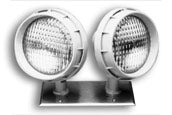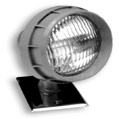When planning an emergency lighting scheme, one thing that should never be forgotten is the installation of remote heads. These units are essentially the same heads that are included on an emergency lighting unit, except they are mounted on a base for single or dual installation, away from (remote from) the main lighting unit.
The main advantage of Remote Heads is that of saving money on your emergency lighting. Since remote heads run off of the power and control circuitry of an existing emergency light, they don’t need their own battery, transformer and circuit board. This causes these units to be considerably less expensive than buying another emergency lighting unit. A two light remote capable emergency light, along with two remote heads or a double remote head is about 1/4 to 1/3 cheaper than buying two emergency lighting units.
VIEW OUR SELECTION OF REMOTE HEADS
They also save money on maintenance, specifically on testing. For every pair of remote heads that you have installed, that’s one less emergency lighting unit that needs to be tested on a monthly basis. Over the long haul, this savings can even greater than the acquisition savings.
CHOOSING REMOTE HEADS
Remote heads are available in a large variety of styles, including:
- Thermoplastic remote heads
- Steel remote heads
- Aluminum remote heads
- Hazardous location remote heads
- Wet location remote heads
- Single lamp remote heads
- Double lamp remote heads
When selecting units, it is most common to select the same type of remote head as the lamp heads on the emergency light. The remote heads are identified with the same type of alphanumeric code for “model numbers” as those used on the emergency lights, to make this easy. You need to insure that the voltage of your remote heads matches the voltage of the emergency light unit that it will be connected to. Too high a voltage rating (on the remote head) will provide inadequate illumination; too low a voltage will burn out the bulb.
WHAT EMERGENCY LIGHT TO USE WITH REMOTE HEADS
These remote heads cannot be used with just any emergency lighting unit, but only with those that are designated “remote capable. The essential difference is in having connections for the wiring to run to the remote head and a battery that is large enough to accommodate the additional current drain of the remote heads.
EMERGENCY LIGHT BATTERY CAPACITY
It is important to insure that your battery capability is sufficient to accommodate the additional current draw of these remote heads, or your battery won’t be able to supply sufficient power to provide lighting for 90 minutes. To calculate the minimum battery size needed you will need to convert the wattage of the lamp to amps. This is done by dividing the wattage rating by the voltage rating. The resulting amperage rating will be a decimal. Add this rating to the rating of all your lamps to find the total current draw of your lamps.
INSTALLING REMOTE HEADS
All remote heads are designed for installation on standard electrical boxes. The most common installation is for a round box, such as used for other ceiling mounted lighting fixtures. Some units require square (duplex) boxes or rectangular (triplex). When specifying your remote heads, be sure to take into account the type of electrical box required for your units.


